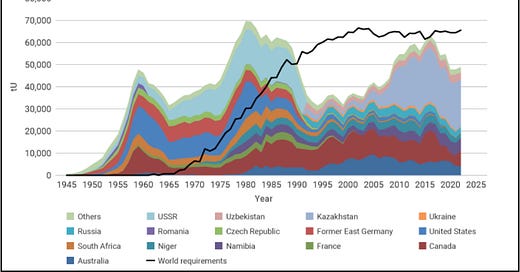Inventories have always played a role in the global nuclear fuel cycle and acted as a buffer against supply shocks as long as commercial nuclear power has existed. Since the creation of Golden Rock, we have spent a lot of time thinking about how today’s industry is a unique period in time as it transitions from one that has relied on inventories to one that will be more production-led from market-based producers.
The chart below which show approximate primary mining supply versus reactor consumption gives us a good basis for understanding the entire history of the uranium mining industry.
Source: OECD-NEA, IAEA, World Nuclear Association
The race to secure uranium during the Cold War was incentivized by governments offering “cost plus” contracts where miners would receive a fixed margin on top of their total costs. Said differently, the more they mined, they more profitable they would be.
Global production peaked in the late 1970s right around the time that western producers were caught running a cartel to maintain market share and high prices. There is a great book to read about the details of this unbelievable true story called, The Great Uranium Cartel by Earle Gray. Production began to falter in the early-mid 1980s as prices sagged and on April 26, 1986, the Chernobyl Nuclear Power Plant experienced a sudden power surge during a test in reactor number four leading to an explosion and fire which has been considered the nuclear power disaster in history.
During the slide in production following Chernobyl, the industry began to experience its first primary mining supply deficits that only briefly got back into balance during the rise of Kazatomprom in the 2000s. Once again, by 2015, uranium was in the midst of a brutal bear market post-Fukushima and production began to be cut back from Paladin, Cameco, Kazatomprom, and other smaller mines by the late teens.
This has led us to where we are today which is, still in a primary mining deficit. Even when we include secondary supplies, the industry slipped into a deficit sometime in 2019 and began drawing down inventories at a rapidly accelerating pace to meet demand.




